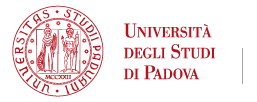

VANESSA CHECCHETTO
Title: Ricercatore a tempo determinato in tenure-track
SSD: BIO/10 - Biochemistry
Address: VIA U. BASSI, 58/B - PADOVA
Phone: 0498276336
E-mail: vanessa.checchetto@unipd.it
Curriculum
2020 – present: Non-tenured assistant professor (RTDa)
DiBio/Unipd/ Italy. Research topic: Study of the role of ion channels in human pathologies.
EDUCATION AND TRAINING
2018 – present: Habilitation for Associate Professorship: 05/E1 (BIO/10 – General Biochemistry) and 05/A2 (BIO/04 – Plant Physiology).
2008-2011: Ph.D. in Biochemistry and Biotechnology - curriculum in Biotechnology . University of Padua, Italy.
2006: Master’s degree in Industrial Biotechnology (Summa cum laude). University of Padua, Italy.
2004: First degree in Biotechnology - Biotechnology . University of Padua, Italy.
TEACHING
From 2020-present: Teaching position as non-tenured assistant professor (RTDa). Topics: Biochemistry, Degree Course in Natural Sciences and Natural and Environmental Sciences. Unipd/Italy.
2020-2021: Teaching position as RTDa. Topics: Experimental Biochemistry, Degree Course in Molecular Biology and in Biotechnology. Unipd/Italy.
2017-2018: Teaching position as contract lecturer for the Course of Biochemistry 1, Degree Course in Biology. Unipd/Italy
2016-2017: Teaching position as contract lecturer for the Course of advanced molecular plant biology, Master's Degree Course in Biomolecular science and evolution. Unife/Italy
From 2008: Integrative/laboratory class teaching for several bachelor’s and master's degree courses (238 hours in total), Unipd/Italy
Since the 2008/2009: Co-supervisor of students of Bachelor’s Degree and Master's Degree and co-tutor of a PhD student (PhD in Biosciences)
PUBLICATIONS
From 2010 to 2023, Vanessa Checchetto authored 40 articles in peer-reviewed scientific journals and international books. Among these publications, she is the first or co-first author on 16, the last or co-last author on 3, and the corresponding author or co-author on 6.
For more details, you can view her profile on Google Scholar: https://scholar.google.it/citations?user=EP8fNxkAAAAJ&hl=it
FUNDING
1. PI of the Integrated Research Budget project of the Department (BIRD-DiBio)
2. Co-PI of the research group for a PRIN project 2022.
3. Member of the research group for the project: National Recovery and Resilience Plan - PNRR - CN3 Spoke 1.
4. Co-partner of the research group for the project: Foundation Cassa di Risparmio di Padova e Rovigo - Call for Scientific Research of Excellence 2021.
ADDITIONAL INFORMATION
Awards and recognition
2021: IJMS (International Journal of Molecular Sciences) 2020 Young Investigator Award in the fields of Molecular Biophysics
2012: Winner of Aldo Gini fellowship to work at CE), Grenoble, France
Research area
In recent decades, ion channels have been identified as crucial pharmacological targets in the development and progression of human diseases. They regulate the flow of ions through the cell membrane, and therefore, it is not surprising that they are involved in various diseases, making them promising targets for therapeutic development. Furthermore, the importance of proteins that interact with ion channels in contributing to the onset and progression of various diseases has been increasingly recognized, positioning ion channels as key components in signal transduction pathways similar to other receptors.
Through my studies, I expect to discover new signaling platforms and deepen the understanding of the mechanisms that regulate key interactions in these pathways. It is anticipated that new mechanisms and previously unknown protein functions will be identified. Simultaneously, the identification of potential interaction sites could open new horizons in the associated pathophysiological processes. In the realm of modern pharmacology, the rational design of protein-protein interaction inhibitors represents a promising and potential-rich area for drug discovery.





